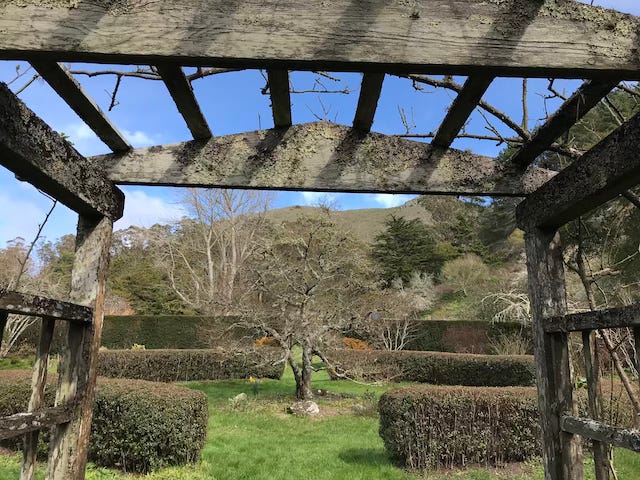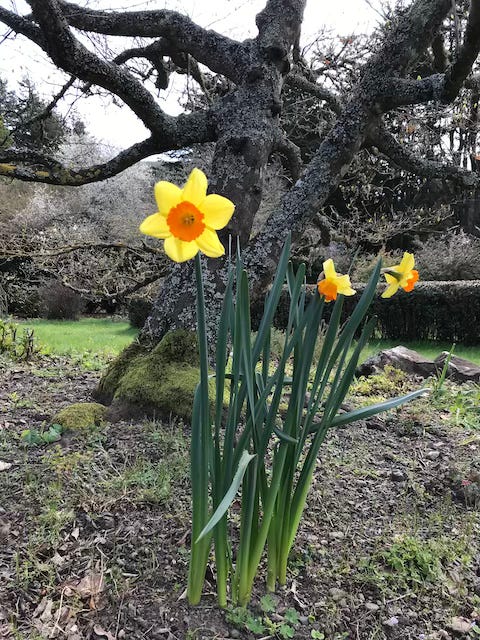Dispatch #23: Monastic Lessons for Managing Monkey Mind
And Awakening Your Inner Monk!
“Monkey mind” is a phrase that I first heard when I began practicing Zen in 2001. I just Googled it and AI (sorry!) told me it comes from the Chinese word xīnyuán or shin'en, which means "heart-mind monkey.” We Buddhists use it to describe how the default mode of ordinary human mind consciousness is restless—just like a monkey swinging from one branch to the next. Just like the monkey, many of us either move from one task to the next without pausing or we’re so fixated on the next branch that we never fully engage with the task at hand before swinging to the next.
This is true even for those of us living in a Zen monastery. Of course the external distractions are minimized, but the monkey mind has a limitless capacity to conjure fantasies, especially when I’m sitting on the meditation cushion. It’s not always (or ever?) easy to unhook from the meanderings of monkey mind, however, it’s vital to exercise our mindfulness muscles whenever we can.
The more I can practice continuity of mindfulness—whether I’m meditating or writing an essay on monkey mind!—the more content I feel. A wandering mind creates suffering. An idle mind makes the “devil’s” work—distractions are the devil when I’m writing. Distracting ourselves from the present moment for whatever reason does nothing but fortify monkey mind and delay dealing with what’s arising in our body-mind. If we stop the mental brachiation even just for a moment, that’s a tiny victory.
Below are some practices that might assist you with managing monkey mind and awakening your inner monk as you go about your everyday activities.
Stop Doomscrolling: I love this new word! It’s clever and describes two of my favorite harmful habits: focusing on the gloom and indulging “entertainment mind.” In this Internet Age, there are innumerable branches of distractions for our monkey minds to swing to-and-fro ad infinitum.
I use two apps to help me stay focused while I’m writing and working. The first is Freedom, which allows me to restrict the applications and websites I have access to by setting up a recurring or daily schedule. Once the session is active, it’s impossible for me to unlock it by turning off my laptop. Plus, you can add more than one device and have different schedules for each one.
The second is Cold Turkey which the brilliant writer and former Zen monk
recommended to me. This application is fantastic for writers as it blocks access to everything on my laptop except for the writing screen. I select when the session ends either by setting a word limit or a time limit.Follow the Schedule: In Zen speak, we call this the “container” of practice. Wholeheartedly following the monastery schedule gradually attenuates the sense of a separate self doing anything, including making simple choices about what time to wake up and what to eat. When we resist the tight container of the schedule our preferences are illuminated: “I don’t want to wake up at 3:50 AM.” “I don’t like amaranth for breakfast!” “I don’t want to sit next to this person in the zendo.”
It’s not that there’s anything wrong with having preferences, that’s just part of being human. However, the value of setting a schedule for yourself—or in corporate speak “time blocking”—is that it helps you notice your preferences and resistances. We often do not notice our likes and dislikes as we go through our day because there’s no container to illuminate them. For example, if you decide to incorporate meditation into your morning routine, you might hear a lot of voices telling you why it’s a waste of time or that there’s all these other activities that are a higher priority—like checking your emails or doomscrolling. When we refrain from giving these voices our attention, they just float through mind consciousness like clouds in the boundless sky.
Resistance is Futile: If you stay at a monastery long enough, you’ll realize how much energy we waste resisting reality. For example, a simple thought such as “I wish it weren’t raining today,” is a harmless preference. However, when this preference is grasped, it can snowball into a world of misery that affects our mood and may spill out and affect how we treat others. Maybe we’re grumpy about having to walk the dog in the rain or drive to work in a downpour, etc. Thinking about how much we hate the rain, or the heat, or the driver who just cut us off, does not alter these circumstances. Often when there’s an experience of discomfort in the body-mind, it’s because there’s a preference that we’re holding onto that we might be unaware of.
One practice that can be helpful is to stop (if that’s possible) what you’re doing and be still for a few minutes and draw your attention to what’s going on in the body-and-mind. If you notice a physical constriction or dense emotion-sensation, that might be where the preference is being held. Sometimes just stopping and noticing helps alleviate the discomfort and shift your perspective about the circumstance so that you can just walk in the rain without frowning or forgive the driver who just cut you off.
To study the way with this body means to study the way with your own body. It is the study of the way using this lump of red flesh. The body comes forth from the study of the way. Everything which comes forth from the study of the way is the true human body. The entire world of the ten directions is nothing but the true human body. The coming and going of birth and death is the true human body.—Eihei Dōgen, “Body-and-Mind Study of the Way” (Kazuaki Tanahashi’s book Moon in a Dewdrop)
MITs in the Morning: Whatever activities you consider are your most important things (MITs), attend to them in the morning. At Tassajara Zen Mountain Center, we wake up at 4:30, and we’re on our meditation cushions in the pre-dawn dark sitting two periods of zazen with walking meditation in between. This is followed by a 30-minute service, oryoki (“just enough”) breakfast, and then a period of study. These are our MMITS—monks’ most important things :>) For me, when I take care of what matters most in the morning, I feel more relaxed and more focused throughout the day.

Sit in the Dark: We meditate in the zendo with diffuse light which decreases visual stimuli and helps the body-mind settle. When we turn off the lights or close our eyes, our other sensory organs become enlivened because we’re no longer relying on our most dominant sense to view the world as it arises. Sitting in the dark affects how we perceive our bodies. Our sense of physical boundaries begins to soften and we feel less separate from the space that surrounds us, and a knowing arises that the wisdom that runs through all things includes us, the walls, floors, the person next to us, etc. This Awake Spaciousness—the Original Face before our parents were born—suffuses all sentient and non-sentient beings.
When Eating, Just Eat: I learned this lesson the hard way. One bright summer day, I was walking down the dirt path at Tassajara while eating a piece of bread slathered in peanut butter. I stumbled on a root or a rock and my shirt became one with the slice! At the monastery, one of the guidelines is “to sit down while eating and drinking.” Had I taken up this practice, I wouldn’t have had to spend time hand washing the PB off my shirt (as you might surmise, there are no washing machines and dryers at Tassajara).
When we practice just doing one activity wholeheartedly, there’s less chance there’ll be a sticky mishap. In Zen speak we call this “bringing zazen mind” to everyday activity. Focusing the wandering mind’s attention on just one activity reinforces the mindfulness that we practice while on the meditation cushion. Here at Tassajara we eat our meals oryoki style— the traditional monastic way of eating in silence and using three nested bowls. Even though I eat much less food when eating this way, I always feel more satisfied afterwards because I focused on eating and not talking—which is no easy feat for this monk of Italian-American heritage ;>)
Expand Your Comfort Zone: Many of us live comfortable lives with modern conveniences at our fingertips: computers, dishwashers, washing machines and dryers, air conditioning, hot water, and electricity. It’s true that many of these ingenious inventions assist us in positive ways, however, we don’t usually notice how reliant we are on them for our peace of mind.


One time during a weeklong retreat at Green Gulch Farm, the power went out while we were eating oryoki lunch in the dining room. All the buildings, except for the one housing the kitchen and bakery, had no electricity for more than 24 hours. This meant that the small, electric fan heater in my guest room no longer worked and I had to sleep and wake up in the cold, and we had to meditate in the dark cold.
I had to monk up and just go where there is no cold. I just practiced over and over with dropping the thoughts of resistance (“I hate being cold.” “How come there’s no central heat in the meditation hall?”)
It’s helpful to step out of our comfort zones and do things that we dislike or are fearful of, that puts others’ needs ahead of our own, and that shakes up our stories of how life should be. Take a cold shower instead of a hot one. Give more than you feel you can afford to your favorite non-profit or to a person living on the street. Visit a country where you can’t speak the language. Drop your opinions and actively listen to others’. Comfort & convenience are overrated!
“Everyday mind” means to maintain an everyday mind in this world or in any world. Yesterday goes forth from this moment, and today comes forth from this place. With going the boundless sky goes, with coming the entire earth comes. This is everyday mind. Body-and-Mind Study of the Way.—Eihei Dōgen, “Body-and-Mind Study of the Way” (Kazuaki Tanahashi’s book Moon in a Dewdrop)
Listen to the Trees: Taste the wind; smell the sunlight; touch the night; collect the heart-mind to see the Original Face.







Thanks Heather.
Great message!